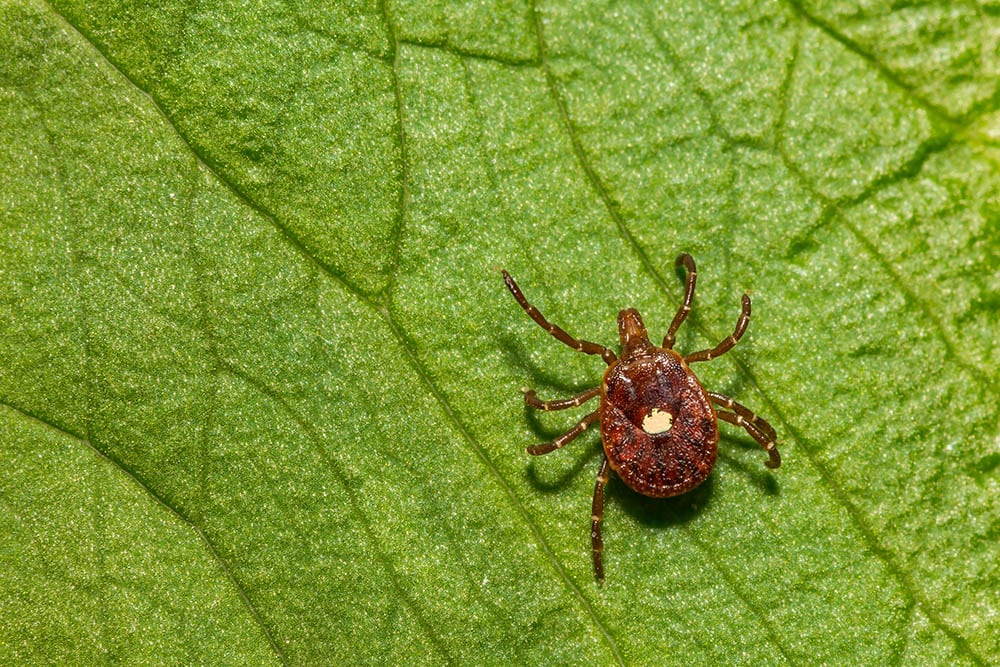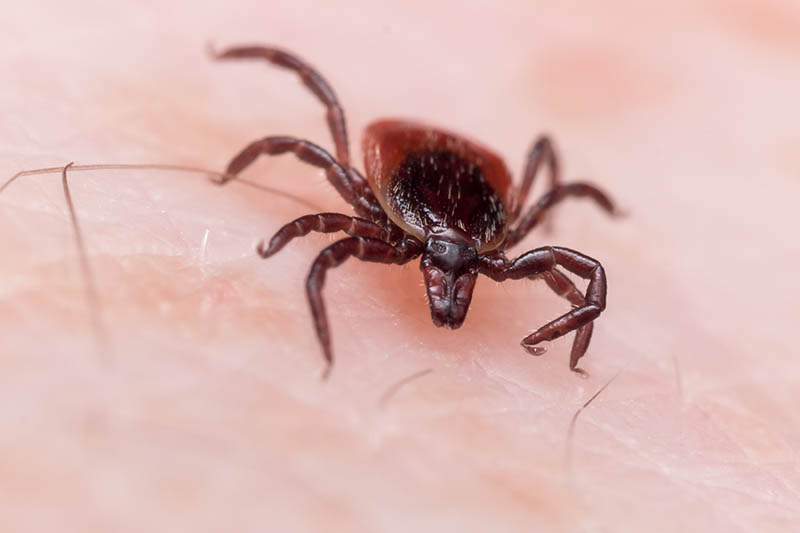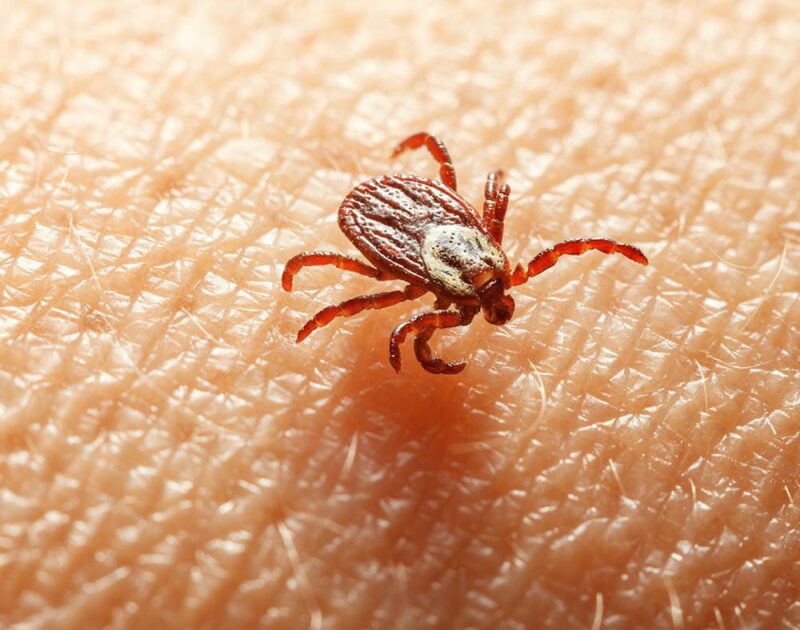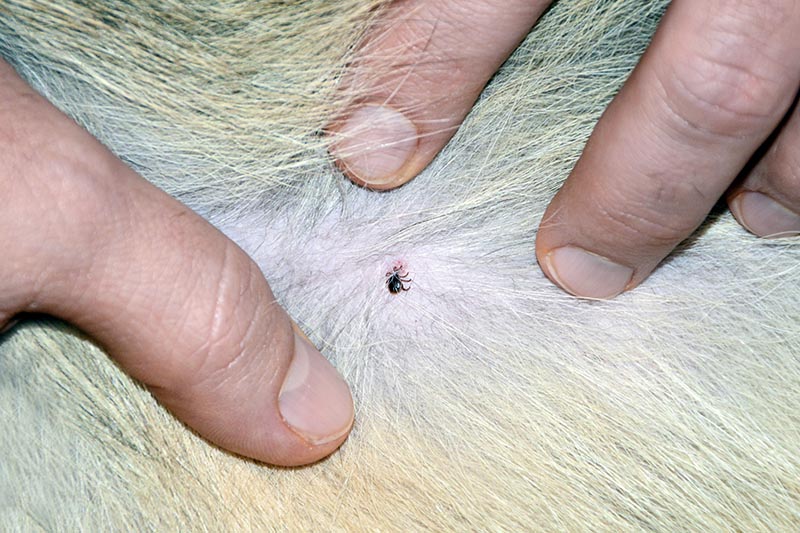6 Types of Ticks in South Carolina (With Pictures)
-

- Last updated:

Pound for pound, ticks are arguably the most dangerous pests in South Carolina. Seed-sized and eager to attach to a host, these parasites are a common vector for diseases across the country, affecting humans, pets, and livestock. On the trail and at home, keeping an eye out for ticks is crucial in avoiding the grab-bag of painful and potentially deadly illnesses they can carry.
Unfortunately, ticks in the Palmetto State have become more varied in recent years, making it more critical to remain vigilant for activity. Learn how you can stay safe with this look at the six types of ticks in South Carolina.
The 6 Types of Ticks in South Carolina
1. Lone Star Tick

| Scientific Name: | Amblyomma americanum |
| Distinguishing Feature: | White spot on back |
Because they cannot fly or jump, Lone Star ticks will climb to the ends of long grass and low growth so they can attach to passing creatures, a habit called questing. Their favored hosts include white-tailed deer and turkeys.
Male ticks are much smaller than females and have backs sporting an array of horseshoe-shaped markings along the edges. Females are easily identifiable by the white patch in the middle of their otherwise brown backs.
Associated Diseases
Nymph and adult Lone Star ticks are quick to bite people and pets. Although they don’t carry Lyme disease, they can transmit a host of bacterial and viral hazards, including:
- Ehrlichiosis
- Tularemia
- Heartland virus
- Bourbon virus
- Southern Tick-Associated Rash Illness (STARI)
- Rocky Mountain spotted fever
Experts also believe that the Lone Star tick may cause alpha-gal allergy. Also called red meat allergy, the condition causes a severe reaction from consuming red meat and other mammalian products that feature alpha-gal molecules.
2. Blacklegged Tick (Deer Tick)

| Scientific Name: | Ixodes scapularis |
| Distinguishing Feature: | Orange-red body w/ black scutum |
Blacklegged ticks sport distinct colorations that aid in their identification. Female adults have a bright orange-red body and a dark brown, circular patch near the head. The smaller male has a dark brown body with a light grayish brown shade around the edges.
Associated Diseases
Blacklegged ticks are the predominant transmitters of Lyme disease in South Carolina. Other diseases they can carry include:
- Babesiosis
- Hard tick relapsing fever
- Anaplasmosis
- Powassan virus
- Ehrlichiosis
While males bite people, only nymph and adult female blacklegged ticks will pass diseases along.
3. American Dog Tick

| Scientific Name: | Dermacentor variabilis |
| Distinguishing Feature: | Light tan scutum |
American dog ticks are larger than Lone Star ticks. Males have a tan back with dark brownish-red splotches. Females take on a dark raspberry/brown color and are distinguishable by the contrasting light tan scuta sitting behind the head.
Associated Diseases
American dog ticks are not known vectors for Lyme disease, but they can harm people and pets with a handful of potential pathogens. They can carry tularemia, a bacteria-borne illness, and are the predominant vector for Rocky Mountain spotted fever, which can cause fever, headaches, and chills. Without timely treatment, it can be fatal.
4. Brown Dog Tick

| Scientific Name: | Rhipicephalus sanguineus |
| Distinguishing Feature: | Flat-brown bodies |
Male and female dog ticks look similar despite the typical size differences. Around the same size as a Lone Star tick, brown dog ticks are distinct in having dark, all-brown bodies.
Associated Diseases
Brown dog ticks rarely transmit diseases to humans but can easily infect dogs. They spread Rocky Mountain spotted fever, canine ehrlichiosis, and canine babesiosis, all of which can be extraordinarily hazardous to your pet’s health.
5. Gulf Coast Tick

| Scientific Name: | Amblyomma maculatum |
| Distinguishing Feature: | Silvery scutum |
The tick’s brown body can sometimes make it hard to distinguish from dog ticks, but looking at the mandibles is an easy way to tell the difference. Gulf Coast ticks have longer mouthparts than dog ticks. Female adults also have notably silver markings around the scuta. Males have similar silvery highlights, but they cascade down the entire length of their backs.
Associate Diseases
The Gulf Coast tick is the only tick to infect hosts with Rickettsia parkeri rickettsiosis. Transmittable to humans, the disease is similar to the closely related Rocky Mountain spotted fever. Like RMSF, the illness can cause fever, headaches, and rash, though you can sometimes tell the difference by an inoculation eschar (an ulcer) around the bite.
6. Asian Longhorned Tick

| Scientific Name: | Haemaphysalis longicornis |
| Distinguishing Feature: | Small bodies |
About the size of the blacklegged tick at ⅛ inch, Asian longhorned ticks can be hard to spot and, apart from their size, difficult to differentiate from other ticks. Their bodies are entirely reddish-brown and lack any notable markings, as you would see with native tick species.
Associated Diseases
Because they’re new to the country, little is clear regarding the specific disease threats of Asian longhorned ticks. They can spread Rocky Mountain spotted fever, and it is unlikely they will transmit Lyme disease. While not a severe threat to humans, livestock is a preferred target for Asian longhorned ticks, and their known illnesses can significantly impact bovine health and populations.
Theileriosis results in cattle developing anemia and jaundice, while babesiosis causes a high mortality rate. There are 17 states with known cases of Asian longhorned ticks, and novel diseases like Theileria are starting to claim the lives of more livestock across a growing collection of states.
Tick Life Cycle and Feeding Habits
The dangerous hard ticks in South Carolina have similar life cycles based on specific feeding points. Most are three-host ticks, meaning they’ll attach to three hosts during their four-stage life cycle. The expected life cycle from egg to death takes 2–3 years. Ticks can survive long stretches between feedings at each stage as they wait for ideal conditions and available hosts.
Ticks begin as eggs, with engorged females birthing 2,000–8,000 eggs, typically in the spring. The eggs hatch into six-legged larvae in the summer and early fall.
Larvae are born on the ground in leaf litter and brush and attach to small passing critters to catch their first blood meal. Depending on the species, larvae may attach to humans and feed on them but are relatively harmless because they have yet to capture a disease from another animal.
After feeding for several days, larvae release from their host and fall to the ground. They then begin molting, usually between fall and spring, eventually turning into eight-legged nymphs. Nymphs perform a similar process of attaching to a host, feeding for 3–9 days, and falling off to molt for several weeks.
Emerging as adults, ticks are now ready for their final meal. Males need to feed to reproduce, though they generally take less time to feed and don’t become engorged like females. The male will detach after feeding and search for an engorged female.
Females will swell to several times their size during the final feeding before mating. The exception is the female Asian longhorned tick, which can reproduce without mating.
After mating, female ticks fall from their hosts so they can give birth. Brown dog ticks are the only ticks that can give birth indoors. Females die shortly after giving birth to the next generation of ticks.

How to Stay Safe from Ticks in South Carolina
Ticks stay active with warm weather, generally when the temperature is above 45°F, meaning South Carolina’s tick season is a little longer than most. Most tick species start feeding in early spring and reach their most active state in the summer. Living indoors, brown dog ticks can stay active all year, which also allows them to complete their life cycles in only a matter of months in some cases.
Staying vigilant during the summer is particularly crucial, but staying safe from ticks can be a year-round affair. Deer ticks can remain active as long as the temperature is above freezing, so there’s sometimes a chance of getting bit by a tick in South Carolina’s mild winters.
Being mindful of the potential danger of ticks at all times will help you better prepare for outdoor excursions.
- Keep pets up to date on flea and tick preventative treatments
- Use an EPA-registered insect spray with an effective tick repellent such as DEET, picaridin, or IR3535
- Treat clothing, boots, and gear with a 0.5% permethrin product
- Wear light-colored long-sleeved shirts and pants, keeping everything tucked around the waist and ankles
- Avoid thickly wooded areas and fields with tall grass and weeds
- Keep the lawn cut and free of debris
- Cut back brush and weeds around the property, particularly when it touches the house
Ticks generally need to stay attached to their host for at least 24 hours before transmitting any diseases, so daily checks keep your family and pets safe. If you’re concerned about ticks after a hike or being outdoors, toss your clothing in the dryer on its highest setting for 20 minutes to kill any stowaways. Take a shower, and check for ticks, particularly around hiding places like the armpits, groin, belly button, knees, and scalp.
Conclusion
The tick problem is becoming more prevalent in South Carolina with the introduction of new species and diseases. And as climate change takes effect, the active season will only become longer each year. Taking necessary precautions to prevent exposure is more crucial than ever. Stay aware of these common ticks in South Carolina, and you’ll have no problem enjoying the great outdoors worry-free.
Featured Image Credit: Stock2468, Shutterstock
Contents

